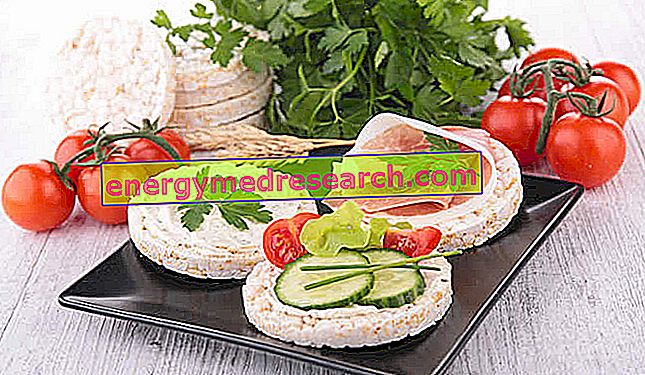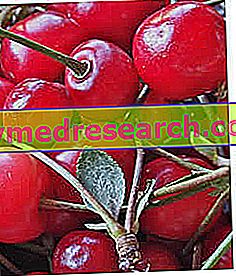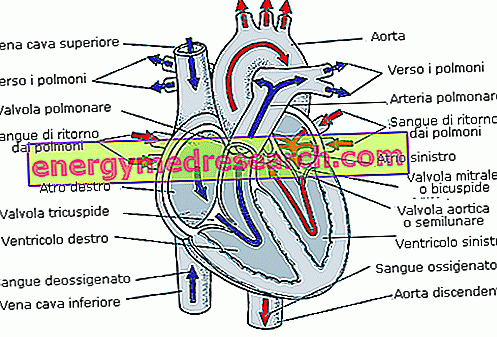Nutritional Features
Rice cakes are a very caloric food, which provides about 35kcal per unit (10g) and just under 400kcal per 100g.
From this first statement we can deduce that rice cakes are not exactly the prototype of diet food; moreover, they are much more energetic than traditional bread. The latter provides on average slightly less than 300kcal / 100g, so a single slice of bread (from 25-30g) provides about 75-90kcal. So, comparing it with a rice cake, a slice of bread provides twice the energy but has a total weight 2.5 / 3 times higher. In practice, a slice of bread has twice the calories but boasts a three times higher satiating power.

The calories of rice cakes are provided mainly by carbohydrates, followed by lipids and finally by proteins. Carbohydrates are almost totally complex (starch), fatty acids are unsaturated and peptides of medium biological value.
Rice cakes give an insufficient fraction of water, do not contain cholesterol and their portion of dietary fiber is quite high.
| Nutritional composition per 100 grams of Commercial Rice Cakes | |||||||||||||||||||||||||||||||||||||||||||||||||||||||||||||||||||||||||||||||||||||||||||||||||||||||||||||||||||||||||
 | |||||||||||||||||||||||||||||||||||||||||||||||||||||||||||||||||||||||||||||||||||||||||||||||||||||||||||||||||||||||||
Nutritional values (per 100 g of edible portion)
| |||||||||||||||||||||||||||||||||||||||||||||||||||||||||||||||||||||||||||||||||||||||||||||||||||||||||||||||||||||||||
From the saline point of view, rice cakes provide a good level of phosphorus, potassium and iron (although the latter is not very bioavailable). As far as vitamins are concerned, the concentrations of niacin (PP), total folates (not shown in the table and probably canceled by the heat treatment of puffed rice) and tocopherols (vit E) stand out.
Rice cakes do not contain simple sugars but, having a high glycemic index (82 out of a maximum value of 100 of glucose syrup), do NOT lend themselves to the diet of the obese, type 2 diabetic and hypertriglyceridemic.
Among other things, due to the scarcity of water, the content in dietary fiber could (instead of improve) worsen a possible condition of constipation; in the event, it is therefore essential for rice cakes to be accompanied by plenty of water or drinks.
It is also important to point out that not all rice cakes are suitable for vegetarian and vegan food, as some use food additives of animal origin as the glue, for example, isinglass.
One last point concerns the suitability of rice cakes for celiacs. Many think that, being based on rice, the biscuits can be easily inserted. However, some of them are produced with glutinous rice, which is why it is always necessary to carefully read the label of the individual products at the time of purchase.
The average portion of rice cakes is variable based on the composition of the general diet; in a 2000kcal nutritional regime, if used as a secondary snack, you can use 20-30g of rice cakes (or 80-115kcal).
Rice Cakes: Are they Contaminate?
Some human nutrition experts from the Technical University of Denmark's National Food Institute have examined the levels of inorganic arsenic and acrylamide in some foods, including rice cakes.
Being two compounds considered to be poisonous - since, at high and lasting exposure, they can increase the risk of cancer - the researchers considered it appropriate to inform the community about their respective levels in food and safety margins; it would in fact be lawful for consumers to want to adopt containment measures for acrylamide and arsenic, in order to moderate the risks associated with their presence in the diet.
Researchers argue that consumers have no reason to worry about most unwanted chemical compounds in food, including arsenic and acrylamide, especially in the context of a varied and heterogeneous diet.
However, the "National Food Institute" claims that "it would be beneficial for everyone if certain compounds were reduced "; these compounds also include inorganic arsenic and acrylamide.
Arsenic
Rice is considered one of the main sources of inorganic arsenic for almost all populations and at all ages; moreover, for children, it seems that the biscuits represent the main way of entering the aforementioned contaminants.
In light of these certainties, the average intake of inorganic arsenic with food (even in safety margins) should be reduced, especially for children. This is because smaller and developing organisms have less tolerance than adult ones; we recall that, if consumed in large quantities and for many years, the chemical element in question could increase the risk of developing some forms of cancer.
It would therefore be desirable (in the diet of those who mainly eat this cereal, like the Asian populations or some Western celiacs) to partially replace the rice with potatoes, bread (possibly without gluten), legumes or other vegetables, to vary the diet and reduce exposure to the poison.
Acrylamide
Acrylamide is another chemical that can be present in rice cakes and increase the risk of certain types of cancer. This unwanted molecule is formed when foods rich in carbohydrates are fried, grilled or baked; however always at temperatures> 120 ° C.
While the research suggests that, since 2007, the average acrylamide intake for the population has decreased, some say that the levels are still too high.
According to a 2013 report, 36% of the acrylamide in the adult diet comes from packaged foods such as potato chips, 30% from coffee and 13% from bread and derivatives (including, of course, biscuits of rice).
How to Avoid the Accumulation of Acrylamide and Arsenic
In addition to avoiding certain types of foods that contain high levels of this substance (those that are very golden or burnt), consumers could take certain safety measures, such as taking a detox supplement.
These types of supplements often contain a mixture of micronized zeolite (a detoxifying volcanic mineral based on silicon and aluminum), alpha lipoic acid (a powerful antioxidant) and / or other antioxidant molecules of vitaminic, mineral, polyphenolic, coenzymatic origin etc.
The composition is justified by the fact that alpha lipoic acid, as well as the other components mentioned, could contribute to limiting the oxidative stress caused by acrylamide, thanks to its remarkable ability to neutralize harmful free radicals throughout the body. The zeolite, meanwhile, thanks to a "cage-like" chemical structure, should exchange heavy metals (including the aforementioned arsenic) in the environment, freeing its ions and preventing toxins from remaining inside the body.
To tell the truth - if it is shown that zeolite can effectively exchange its ions with heavy metals, enclosing them, and that antioxidants have a certain effectiveness in combating oxidative stress - there is no guarantee that the aforementioned supplements will cancel the presence or the effect of arsenic and acrylamide in foods. Among other things, the use of clays in food supplements has recently been announced by the Ministry of Health, in order to reduce consumer exposure to aluminum food sources.
Taking antioxidant and "detoxifying" supplements could therefore be a correct habit, but diet remains the most important form of prevention ever.



